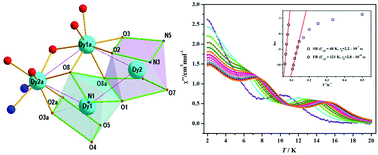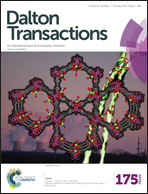Multiple magnetic relaxation processes, magnetocaloric effect and fluorescence properties of rhombus-shaped tetranuclear rare earth complexes†
Abstract
Seven new tetranuclear rare earth (RE) complexes [RE4(acac)4L6(μ3-OH)2] (HL = 5-(4-fluorobenzylidene)-8-hydroxylquinoline; acac = acetylacetonate; RE = Y (1), Eu (2), Gd (3), Tb (4), Dy (5), Tm (6) and Lu (7)) have been synthesized and completely characterized. Complex 5 exhibits multiple zero-field slow magnetic relaxation processes typical of Single Molecule Magnets (SMMs). Two distinct slow magnetic relaxation processes, with effective energy barriers of Ueff = 48 K for the slow relaxation (SR) process and Ueff = 121 K for the fast relaxation (FR) process, are mainly attributed to the presence of two crystallographically independent Dy(III) sites. The magnetocaloric effect (MCE) was detected as −ΔSm(T) = 20.8 J kg−1 K−1 for complex 3. The fluorescence properties of complexes 1, 2, 4, 5 and 7 were also investigated. Complexes 2, 4 and 5 show the characteristic peaks for their corresponding RE(III) center, while complexes 1 and 7 show similar emission peaks to the Schiff base ligand when they are excited at the appropriate wavelength.


 Please wait while we load your content...
Please wait while we load your content...